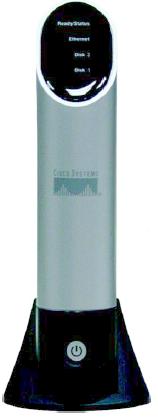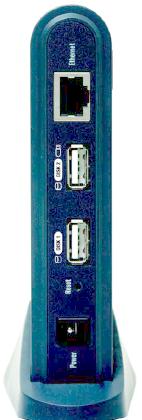Inexpensive uClinux-powered gadget to popularize NAS?
Jul 9, 2004 — by LinuxDevices Staff — from the LinuxDevices Archive — 3 views Tom's Networking has published a thorough review of a small, inexpensive embedded Linux appliance from Linksys that could popularize network-attached storage (NAS). The $75 Network Storage Link for USB 2.0 Disk Drives (NSLU2) turns external USB drives into NAS devices with powerful automatic backup… capabilities.
Tom's Networking has published a thorough review of a small, inexpensive embedded Linux appliance from Linksys that could popularize network-attached storage (NAS). The $75 Network Storage Link for USB 2.0 Disk Drives (NSLU2) turns external USB drives into NAS devices with powerful automatic backup… capabilities.
(Click for larger view of NSLU2)
According to the review, the NSLU2 is the first network-attached storage (NAS) device to ship without internal drives or drive bays. Like D-Link's USB home drive, the fanless device is based on an Intel IXP420 network processor, and is about the size of a small cassette player. It offers a single 10/100 Ethernet port and dual USB 2.0 ports. It works with external USB drives formated with Linux's default ext3 filesystem.
The device is based on SnapGear Embedded Linux, a form of uClinux. Linksys, which ran afoul of GPL rights activists a year ago, is taking no chances with the NSL, and is distributing a CD with full source code with the device.
The NSL can be configured using a Web-based interface, or with a supplied Windows-based setup wizard. It supports both dynamic and static IP address configurations. The Web-based configuration interface can not be disabled after setup, and it allows the administrative password to be changed without requiring the user to log in, according to the review. In other words, the device is not very secure, as supplied, and should not be used to serve files across the open Internet.
The device has two USB ports, and can support two USB drives or one USB drive and a Flash USB memory device, which can be formatted using the Web interface.


The NSLU2, front and back views
Out of the box, the device creates a “guest” share giving read/write permissions to the entire network. It also creates an “admin1” share, requiring login with the default admin username and password. Additional shares can be created using the Web interface. Users can be assigned to groups, and allotted quotas with 1MB granularity. The review finds some flaws with the way permissions are handled for nested folders, however.
The web interface also supports remote logging configuration, email alerts, firmware upgrades, timezone configuration, Samba configuration, factory defaults reset, shutdown and restart, and documentation. It does not enable you to disable the web interface, set up ftp file access, or view quota status.
The reviewer praises the NSL extensively for its powerful built-in backup system, which supports daily or less frequent drive backups, as well as full or incremental file backups. He reports that Linksys has fixed a bug that caused dates to be modified incorrectly with the V2.3R21 firmware version.
The reviewer tested performance using a benchmarking suite, and found write performance to be excellent, especially with files small enough to be cached on the host computer. Read performance, in contrast, is fairly slow, at about 8MB/sec.
The review ends with the prediction that the inexpensive NSL will revolutionize NAS by making it much more accessible and easy to use.
Read full review at Tom's Networking
This article was originally published on LinuxDevices.com and has been donated to the open source community by QuinStreet Inc. Please visit LinuxToday.com for up-to-date news and articles about Linux and open source.